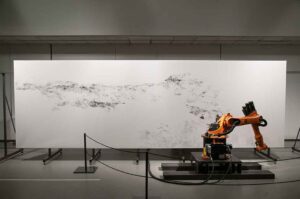
Big Picture
In an attempt to bridge the gap, breakdown barriers and perhaps change culturally ingrained perceptions created by literature and the film industry about how humans and robots interact, artists Mathias Gommel, Marinta Haitz, and Jan Zapper of robotlab, have set up a sophisticated play date between humans and robots, in order to ease the transition into this inevitable partnering. Their exhibition featuring the work ‘Bios and the Big Picture’ continues through September 3, 2017 at Wood Street Galleries, Pittsburgh PA.

There is a lot of hoopla around the robotics industry here in Pittsburgh. Much attention is being placed on the development of self-driving cars and the rebranding of the city, rightfully so, as a global technological player. The work of these artists is a perfect reflection of this zeitgeist. The German based collective has partnered with KUKA, a German manufacturer of industrial robots, for their project.
They have created specialized writing/drawing instruments which they have attached to a KUKA robot. These attachments enable the robots to either write, using calligraphy in this case the Bible or draw in a continuous line a representation of panoramic photographs of the mars landscape taken by NASA’s the Curiosity Rover. Of course all of this is only possible with the complex behind the scenes control systems and coding developed and put into place by Gommel, Hiatz and Zapper. The machines operate on a 24/7 schedule.
Functioning like a minimalist performance piece the artists have removed themselves physically from the making of the pieces, substituting the robots for their corporeal presence. The artists claim that the role of the machine is always defined as that of an autonomous creative agent. If the machine is capable of making its own decisions about the translation, hasn’t this been programmed into its process? So, is it really autonomous? Is it like an automatic drawing? It is like a modern day circus, step right up to see the one armed robot recreate the bible by writing for six straight months, that spectacle alone is worth the price of admission. But what does it mean to be human and what is the role of all of this technology? Soon, at least we are told, humans will no on longer drive their own cars, many manufacturing jobs have already been replaced by robots and now perhaps there will eventually be no need for artists — they too will be replaced by robots.
One could look at the robot as a kind of prodigy. An analogy would be to compare it to the making of a virtuoso performer, someone who has been trained from an early age to technically master something. But no matter how technically proficient someone is at playing an instrument, what differentiates the best artist from just the master craftsperson is the heart, soul and the emotional maturity at which one plays. If we can program a robot to play an instrument at a level beyond what a human can perform, without the essential human components, will it move us? Can a robot have feelings?
There is an undeniable utopian narrative created and propagated by the makers of this relatively new developing technologically evolving world. This powerful narrative drives the economic juggernaut of technology and has really become the new opiate of the masses. It is easy to succumb. For some this new world generates a feeling of a loss of control and powerlessness perhaps the stripping away of what makes us human: the ability to work, create, love. Our future will be determined by an elite, highly trained and skilled specialized group of people who are the ‘haves’ and the rest of us just make up the sedated masses of ‘have nots’ who are hoping that the new god is a benevolent one. Perhaps having Man Machine by Kraftwerk playing in the background would make all of this an easier pill to swallow.
SCOTT TURRI lectures at the University of Pittsburgh. his practice has been inextricably linked to how the information age is shaping visual culture
Volume 32 no. 1 September/October 2017 p 28

